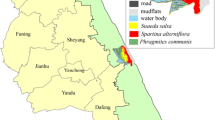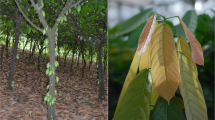Abstract
A very effective tool to combat desertification is revegetation. Promising species for this purpose are the evergreen shrubs of the genus Atriplex. The objective of the research was to study the growing responses of Atriplex halimus under different thermal regimes and to evaluate the biomass accumulation of selected clones. The test was carried out in four sites of Sardinia Island (Italy) characterized by different latitude, altitude and air temperature trends along the year. In every site, potted plants of five clones of A. halimus were compared for biomass production as measured by linear growth of plants (central axis and secondary shoots), as well as by dry weight of leaves, shoots and roots per plant. Correlations between sums of hour-degrees under or above the thresholds of critical air temperatures, comprised between 0 and 35 °C, and the plant growth indicators were analysed. Differences among the five clones, with regard to the influence of low temperatures on plant growth and on the biomass production were evaluated. Among five tested clones, GIO1 and SAN3 resulted more sensitive to low temperatures. Clones MAR1, PAL1 and FAN3 resulted less sensitive to low temperatures and in the site characterized by the lowest minimum temperatures also have shown greater adaptability and thus biomass growth in the observed period. The clone PAL1 showed a lower shoot/root biomass ratio as adaptation to cold temperature, and the clone FAN3, the opposite behaviour and a general preference to temperate thermal regimes.





Similar content being viewed by others
References
Aouissat M, Walker DJ, Belkhodja M, Fares S, Correal E (2009) Freezing tolerance in Algerian populations of Atriplex halimus and Atriplex canescens. Span J Agric Res 7:672–679
Bean W (1981) Trees and shrubs hardy in Great Britain. Vol 1–4 and supplement. Murray, Clapham
Belkheiri O, Mulas M (2013a) The effects of salt stress on growth, water relations and ion accumulation in two halophyte Atriplex species. Environ Exp Bot 86:17–28. doi:10.1016/j.envexpbot.2011.07.001
Belkheiri O, Mulas M (2013b) Effect of water stress on growth, water use efficiency and gas exchange as related to osmotic adjustment of two halophytes Atriplex spp. Funct Plant Biol 40:466–474. doi:10.1071/FP12245
Caldwell MM, Osmond CB, Nott DL (1977) C4 pathway photosynthesis at low temperature in cold-tolerant Atriplex Species. Plant Physiol 60:157–164
Choukr-Allah R (1991) The use of halophytes for the agriculture development of the south of Morocco. In: Choukr-Allah R (ed) Proc Int Conf Agricultural Management of Salt- Affected Areas, Agadir, Morocco, 25 April 1991, pp 377–386
Dessena L, Mulas M (2012a) Cultivar selection from spontaneous population of Atriplex halimus L. Acta Horticult 937:205–210
Dessena L, Mulas M (2012b) Mediterranean saltbush (Atriplex halimus L.) as an ornamental species for arid environments. Acta Horticult 937:211–216
El Aich A (1987) Fodder trees and shrubs in range and farming systems in North Africa. Food and Agricultural (FAO) report, Rome
El-Shatnawi MJ, Mohawesh Y (2000) Seasonal chemical composition of saltbush in semiarid grassland of Jordan. J Range Manag 53:211–214
Ercoli L, Mariotti M, Masoni A, Arduini I (2004) Growth responses of sorghum plants to chilling temperature and duration of exposure. Eur J Agron 21:93–103
Falasca SL, Pizzarro MJ, Mezher RN (2014) The agro-ecological suitability of Atriplex nummularia and A. halimus for biomass production in Argentine saline drylands. Int J Biometeorol 58:1433–1441
Haddioui A, Baaziz M (2001) Genetic diversity of natural populations of Atriplex halimus L. in Morocco: an isoenzyme-based overview. Euphytica 121:99–106
Hnilickova H, Duffek J, Hnilicka F (2002) Effect of low temperatures on photosyntesis and growth in selected tomato varieties Lycopersicon esculentum Mill. Sci Agric Bohem 33:101–105
Huxley A (1992) The new RHS dictionary of gardening. Royal Horticultural Society. Macmillan, London
Kalberer SR, Wisniewski M, Arora R (2006) Deacclimation and reacclimation of cold-hardy plants: current understanding and emerging concepts. Plant Sci 171:3–16
Kinet JM, Benrebiha E, Bouzid S, Laihacar S, Dutuit P (1998) Biodiversity study on Atriplex halimus for in vitro and in vivo detection of plants resistant to harsh environmental conditions and for potential micropropagation. Cah Agric 7:505–509
Mulas M, Mulas G (2004) The strategic use of Atriplex and Opuntia to combat desertification. University of Sassari (Italy), Desertification Research Center: www.uniss/nrd.it
Mulas M, Bellavite D, Lubino M, Belkheiri O, Enne G (2012) Participatory approach for integrated development and management of North African marginal zones: demonstrative plan to fight desertification in Morocco and Tunisia. Ital J Agron 7:351–354. doi:10.4081/ija.2012.e46
Prášil IT, Prášilová P, Mařik P (2007) Comparative study of direct and indirect evaluations of frost tolerance in barley. Field Crop Res 102:1–8
Rapacz M, Tokarz K, Janowiak F (2001) The initiation of elongation growth during long-term low-temperature stay of spring-type oilseed rape may trigger loss of frost resistance and changes in photosynthetic apparatus. Plant Sci 161:221–230
Salahas G, Cormas E, Zervoudakis G (2002) Cold inactivation of phosphoenolpyruvate carboxylase and pyruvate orthophosphate dikinase from the C4 perennial plant Atriplex halimus. Russ J Plant Physiol 49:211–215
Steffen KL, Arora R, Palta JP (1989) Relative sensitivity of photosynthesis and respiration to freeze-thaw stress in herbaceous species. Plant Physiol 89:1372–1379
Strand A, Hurry V, Henkes S, Huner N, Gustafsson P, Gardeström P, Stitt M (1999) Acclimation of Arabidopsis leaves developing at low temperatures. Increasing cytoplasmic volume accompanies increased activities of enzymes in the Calvin cycle and in the sucrose-biosynthesis pathway. Plant Physiol 119:1387–1397
Walker DJ, Romero P, De Hoyos A, Correal E (2008) Seasonal changes in cold tolerance, water relations and accumulation of cations and compatible solutes in Atriplex halimus L. Environ Exp Bot 64:217–224
Walker DJ, Lutts S, Sánchez-García M, Correal E (2014) Atriplex halimus L.: its biology and uses. J Arid Environ 100–101:111–121
Wilkinson S, Clephan AL, Davies WJ (2001) Rapid low temperature-induced stomatal closure occurs in cold-tolerant Commelina communis leaves but not in cold-sensitive tobacco leaves, via a mechanism that involves apoplastic calcium but not abscisic acid. Plant Physiol 126:1566–1578
Wilson AD (1977) The digestibility and voluntary intake of the leaves of trees and shrubs by sheep and goats. Aust J Agric Res 28:501–508
Xia JH, Zhao H, Liu WZ, Li LG, He YK (2009) Role of cytokinin and salicylic acid in plant growth at low temperatures. Plant Growth Regul 57:211–221
Zervoudakis G, Angelopoulos K, Salahas G, Georgiou CD (1998) Differences in cold inactivation of phosphoenolpyruvate carboxylase among C4 species: the effect of pH and of enzyme concentration. Photosynthetica 35:169–175
Zucca C, Pulido-Fernandez M, Fava F, Dessena L, Mulas M (2013) Effects of restoration actions on soil and landscape functions: Atriplex nummularia L. plantations in Ouled Dlim (Central Morocco). Soil Tillage Res 133:101–110. doi:10.1016/j.still.2013.04.002
Zucca C, Weicheng W, Dessena L, Mulas M (2015) Assessing the effectiveness of land restoration interventions in dry lands by multitemporal remote sensing. A case study in Ouled Dlim (Marrakesh, Morocco). Land Degrad Dev 26:80–91. doi:10.1002/ldr.2307
Ethical standards
Authors declare that the experiments comply with the current laws of the Italy, which is the country in which they were performed.
Author information
Authors and Affiliations
Corresponding author
Electronic supplementary material
Below is the link to the electronic supplementary material.
Online Resource 1
(PDF 42 kb)
Online Resource 2
(PDF 59 kb)
Online Resource 3
(PDF 59 kb)
Rights and permissions
About this article
Cite this article
Dessena, L., Mulas, M. Influence of temperature on biomass production of clones of Atriplex halimus . Int J Biometeorol 60, 677–686 (2016). https://doi.org/10.1007/s00484-015-1062-2
Received:
Revised:
Accepted:
Published:
Issue Date:
DOI: https://doi.org/10.1007/s00484-015-1062-2




